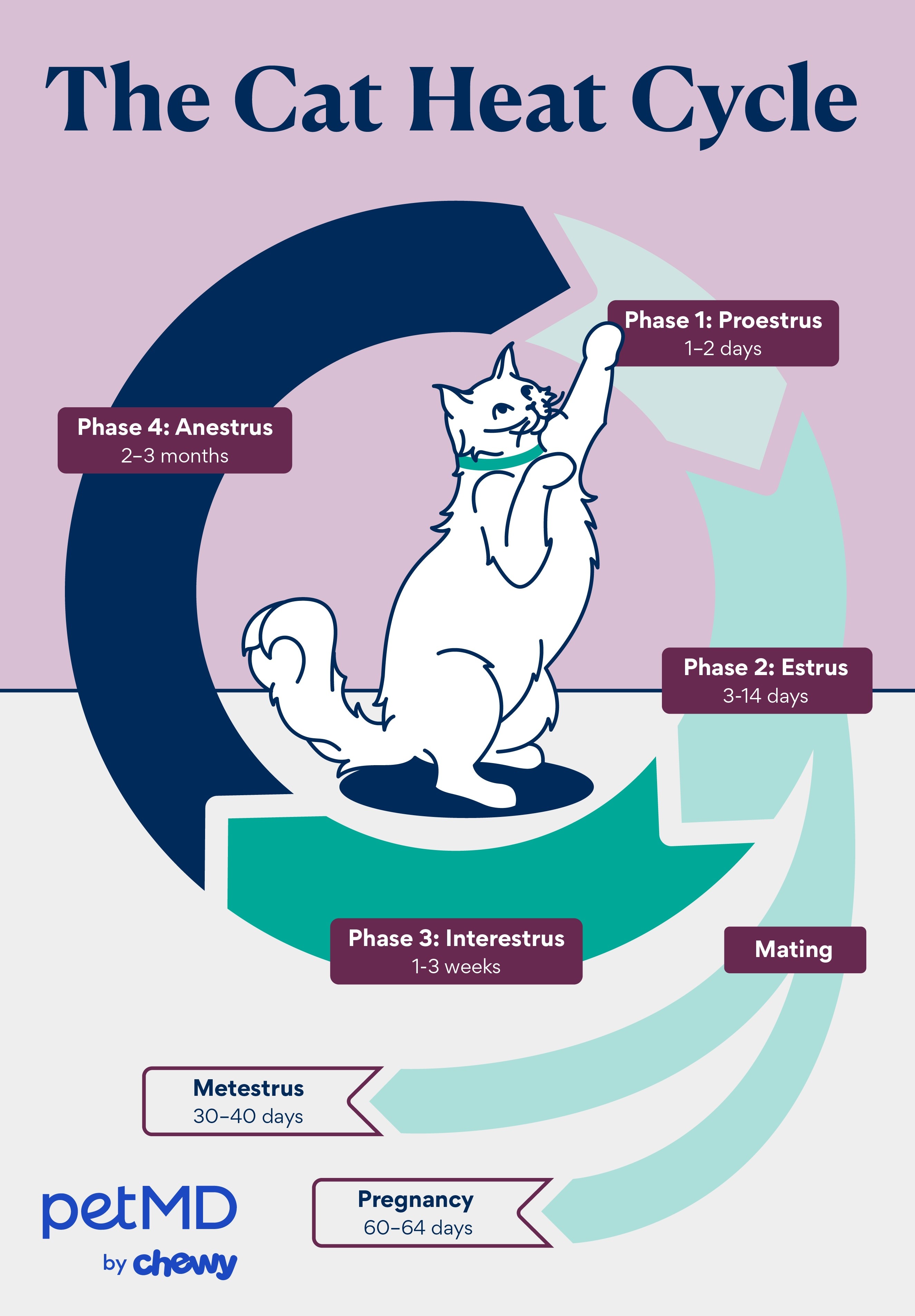For those new to cat ownership or those curious about feline reproductive health, understanding the heat cycle in female cats, known as queens, is essential. Unlike dogs or humans, a cat’s estrous cycle has unique characteristics. If your cat is not spayed, recognizing the signs of being in heat is crucial for responsible pet care.
Decoding the Age of First Heat in Cats
Generally, cats begin their heat cycles between 5 to 9 months of age. However, this can vary significantly. Some kittens may start as early as 3-4 months old, while others might not experience their first heat until they are around 18 months. Factors such as breed, weight, and the time of year play a significant role in determining when a cat first goes into heat.
Unpacking the Duration of a Cat’s Heat Cycle
 illustration depicting a cat
illustration depicting a cat
The feline heat cycle isn’t a single event but a series of stages, each with varying lengths and characteristics. It’s composed of four primary stages:
Proestrus: The Initial Stage
Proestrus marks the beginning of the heat cycle. During this phase, estrogen levels in the cat’s body start to rise. Proestrus typically lasts for a brief period, around one to two days. Notably, there are usually no outwardly visible symptoms of proestrus in cats that are apparent to owners. However, male cats might detect hormonal changes and show increased interest, though the female cat will not yet be receptive to mating.
Estrus: The “In Heat” Phase
Estrus is the most recognizable stage of the feline heat cycle and what most people refer to when they say a cat is “in heat.” This phase generally lasts for about a week, but it can range from 3 to 14 days. During estrus, a female cat exhibits noticeable behavioral changes. She may become excessively affectionate, vocalize more than usual—often with a distinctive “calling” sound—and display signs of restlessness. This is the stage when the queen is receptive to mating and can become pregnant.
Interestrus and Metestrus: Post-Estrus Intervals
Interestrus and metestrus are potential periods that occur after the estrus phase, depending on whether ovulation occurs. Cats are induced ovulators, meaning they typically only release eggs from their ovaries after mating.
- Metestrus: If mating occurs during estrus, the act of mating triggers the release of eggs. If fertilization of these eggs does not happen, the cat enters metestrus. This stage involves a pause in the cycle and lasts for approximately 30–40 days. If fertilization does occur, it leads to pregnancy, which lasts about 60–64 days.
- Interestrus: If a cat in estrus does not mate and, therefore, does not ovulate, she will enter interestrus. During this period, in-heat behaviors subside for about one to three weeks. Following interestrus, the cycle will restart with proestrus.
Anestrus: The Inactive Phase
Cats are seasonal breeders, and their heat cycles are influenced by daylight hours. Anestrus is a period of reproductive inactivity. Between active cycling periods, cats experience anestrus for about two to three months. During anestrus, there is minimal hormonal activity, and the cat is not in heat. This phase typically occurs during the shorter daylight months of the year.
Frequency of Heat Cycles in Cats
The frequency of cat heat cycles is largely dictated by seasonal changes and the amount of daylight. Cats are “long-day breeders,” meaning their reproductive cycles are most active when daylight hours are longer. Consequently, heat cycles become more frequent starting in the spring, typically peaking from February to April. These cycles can continue through October or November before the anestrus period begins. The cycle will be interrupted by pregnancy if breeding occurs.
Recognizing the Signs of a Cat in Heat
Unlike dogs and humans, cats do not experience bleeding during their heat cycle. The primary indicators that a cat is in heat are behavioral changes. A cat in heat might:
- Become excessively affectionate towards people and other pets.
- Vocalize frequently and loudly, often described as “calling.”
- Exhibit a decreased appetite.
- Appear restless or agitated.
- In rare cases, urinate more frequently or outside the litter box, though these are less common signs.
Some cat owners may worry that their cat is in pain due to the intensity of these behavioral changes. If you are concerned about sudden behavioral shifts in your cat, it is always best to consult with your veterinarian.
Managing a Cat in Heat
If you wish to prevent pregnancy, it’s crucial to keep female cats indoors while they are in heat. Beyond this precaution, no other lifestyle changes are strictly necessary for a cat in heat.
For those who do not plan to spay their cat, careful observation of the duration and frequency of heat cycles is important to monitor for potential complications like pseudopregnancy (false pregnancy) or mucometra (accumulation of mucus in the uterus). Pyometra, a serious uterine infection, is a life-threatening condition that can occur at any age but is more common in middle-aged queens.
Seek veterinary attention immediately if your cat exhibits any of the following symptoms during or after her heat cycle:
- Lethargy or weakness
- Loss of appetite
- Fever
- Vaginal discharge (especially if it is pus-like or bloody)
- Swollen abdomen
Preventing Heat Cycles in Cats
Spaying, which involves the surgical removal of the uterus and ovaries, is the only definitive way to prevent heat cycles and pregnancy in female cats. Unless you are a responsible breeder and your cat is part of a recognized breeding program, spaying is highly recommended.
Spaying not only prevents unwanted litters but also offers significant health benefits. Unspayed cats are at a higher risk of developing pyometra, pseudopregnancy, mammary cancer, and ovarian cancer.
There are no proven health advantages to allowing a cat to experience a heat cycle before spaying. Veterinary professionals typically recommend spaying kittens at 5–6 months of age, ideally before they even begin their heat cycles.
Frequently Asked Questions About Cats in Heat
Do cats bleed when they are in heat?
No, cats should not bleed during a heat cycle. While a clear vaginal discharge can sometimes occur during proestrus, any bloody discharge is abnormal and requires immediate veterinary attention.
Is it possible to spay a cat while she is in heat?
Yes, spaying a cat in heat is possible and safe. Waiting for a cat to go out of heat to perform a spay surgery is not necessary and could increase the risk of unwanted pregnancy or other health issues. Veterinarians are equipped to spay cats at any stage of their cycle.
Do male cats go into heat?
No, male cats do not experience heat cycles. Heat cycles are a feature of the female reproductive system related to ovulation. However, intact male cats are capable of mating at any time, especially when they detect a female cat in heat.
How many days does a cat stay in heat?
The estrus stage, or the primary “in heat” phase characterized by behavioral changes and receptivity to mating, typically lasts for 3 to 14 days, with an average duration of about one week.
How can I tell if my cat is in heat?
If you suspect your cat is in heat, observe her behavior for typical signs such as increased vocalization, excessive affection, restlessness, and potentially a decreased appetite. If you are unsure, consult with your veterinarian for confirmation and guidance.
WRITTEN BY
Jamie Lovejoy, DVM
Veterinarian
Dr. Jamie Lovejoy graduated from Tufts Cummings School of Veterinary Medicine in 2012 after completing her undergraduate studies in Marine Biology.

